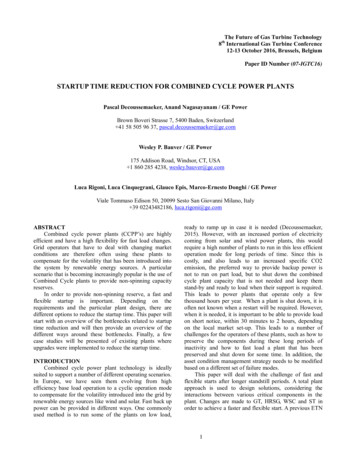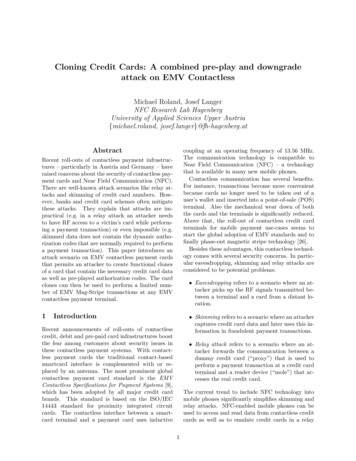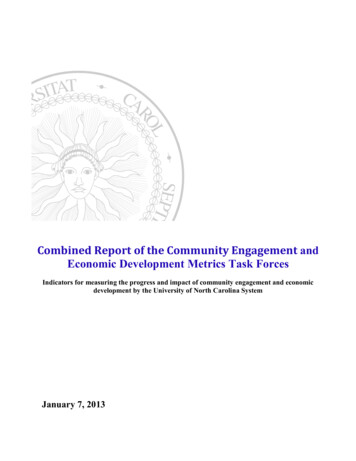
Transcription
Proceedings of the 2nd African International Conference on Industrial Engineering and Operations ManagementHarare, Zimbabwe, December 7-10, 2020Energy Productions Using Combined Cycle Gas and Vaporat Maputo Thermal Power PlantMiguel Meque Uamusse, Acacio Zimbico, Marcelino Januário Rodrigues, JonasValente Matsinhe and Alberto Júlio TsambaFaculdade de Engenaria, Universidade Eduardo MondlaneAv de Mocambique, P.O.Box 257 km 1.5Maputo, MozambiqueABSTRACTAccess to electricity is one of the instruments for the development of any society nowadays, about 1.2 billion peoplein the world are living without electricity today. At least 600 million people in sub-Saharan African countries arelivingwithout electricity, and the Maputo province and Maputo city in Mozambique are not any exception faced withthe electrical shortage. The UN Sustainable Development Goal (SDG) 7 states that access to affordable, reliable,sustainable, and modern energy for all people throughout the world should be achieved by the year 2030. The rate ofelectrification in the urban areas in Mozambique is about 67% and the national electrification rate is 40%. With higherenergy potential resources such as coal, natural gas, and renewable energy resources. Mozambique still has one of thelow electricity consumption per capita in the region about 443 kWh which is paradoxes. The government ofMozambique has introduced reforms in the electricity sector since 1995 and considers the access to modern forms ofsupplying electricity to be highly important in the fight being waged against poverty. The objective of this research isto see the process of the gas conversion to electricity using the combined cycle gas and vapor at Maputo Power Plantin Maputo, Mozambique. In this secondment, the rigorous chemical analysis of water in the Power Plant is of relevancyfor obtaining improved water quality which is intimately related to good energy production. To succeed this goals, welook forward to implementing Desalination and demineralization methods of water from locally constructed wells thatis actually used to operationalize the generation process of the combined system.KeywordsEnergy, combined gas-vapor thermal power plant, desalinization, demineralization1. IntroductionsThe current scenario of electricity access in Mozambique is not much favorable to eradicate poverty because the ruralarea still has low rata electrifications with 27% and a compere in Sweden is 100% while the urban area in Mozambiqueis about 67%and the national electrifications rate is 40% (EDM, u.d.). With higher energy potential resources (coal,natural gas, renewable energy resources) Mozambique still has low electricity consumption per capita about 443kWh(Uamusse, et al., 2019). The Figure.1 show the electricity production and consumption of the last eighteen years.Today Mozambique the energy consumption average is 12 billion kWh (Mulder & Tembe, 2018). The UN SustainableDevelopment Goal (SDG) 7 states that access to affordable, reliable, sustainable and modern energy for all people IEOM Society International1532
Proceedings of the 2nd African International Conference on Industrial Engineering and Operations ManagementHarare, Zimbabwe, December 7-10, 2020throughout the world should be achieved by the year 2030. This “requires expanding access to electricity and cleancooking fuels and technologies, as well as improving energy efficiency and increasing the share of renewable energy”,for those in need of this (UN, 2018).Three socio-economic effects of electrification stand out, even if it has recently been questioned based on experiencegained in Asia and Latin America whether these results are fully transferrable to the African context and specificallyto Mozambique. Positive effects of full access to electrification are often stated as being, in particular, educationalbenefits, improvements in income, and a decrease in respiratory diseases (Uamusse, et al., 2019). Electrification andSDG Goal 7 have also been related to several other important SDG goals, among these the following: 1) overcomingpoverty, 3) achieving good health and well-being, 4) providing an education of high quality, 6) providing clean waterand good sanitation, 8) providing decent work and economic growth, 9) promoting industrial development, innovation,and infrastructure improvement , and 13) supporting actions regarding climate matters. Thus, electrification and SDG7 can be seen as enabling factors for achieving an adequate degree of sustainable developmentFigure 1: Mozambique energy productions, import and exportations (Uamusse, et al., 2019)The present work is currently developed at Electricidade de Moçambique (EDM) in Maputo, at Maputo ThermalPower Plant (CTM) that operates according to two thermodynamic cycles (Gas and steam or Vapor). This plant aimsto supply electricity to Maputo. The Mozambique power utility, "Electricidade de Moçambique, E.P." (EDM) managesthe bulk of the electricity distribution in Mozambique, it is also responsible for power generation facilities andtransport infrastructures along with the country. Fig 2 depicts the Maputo Power Plant Layout. This infraestructurehas install two gas turbine units installed and one vapor turbine. The gas turbine is working using the Brayton cycleand the vapor turbine working using the Rankine cycle with total energy productions 106 M.The main objective for secondment of engineering academics was to expose them to industrial systems, modernequipment, and engineering methods to inculcate a culture of practical and relevant applications. Moreover, in thisperspective, the study will be in two months and at the end willFigure 2: Maputo thermal power plant. The Maputo Thermal Power Plant (CTM) that operates according to twothermodynamic cycles (Gas and steam or Vapor) (EDM, u.d.) IEOM Society International1533
Proceedings of the 2nd African International Conference on Industrial Engineering and Operations ManagementHarare, Zimbabwe, December 7-10, 20202. MethodologyThe methodology for this work will comprise two phases as presented is subsections 2.1 and 2.2. The first one, willbe the principle of operation of the plant system, which consists of understand the combined thermodynamic cyclegas and steam and shows in Fig 3 and, is described in subsection 2.1. The next method for this training is the waterquality analysis in the Power Plant that should be improved to have good energy production and the water qualitymethods will be Desalination and demineralization of water from Maputo city. Fig 3 is showing the combined gasand vapor turbine and the principle of operations the exhaust gases from the gas turbine cycle serve to heat the waterused in the steam or Rankine cycle and contributing to increasing the efficiency of energy production and efficiencyclose to 50% .Figure 3: The combined thermodynamic cycle gas and steam.In the coming months the work will focus on the reoperation of a group of turbines that has been stopped due to abreakdown and improvement of water quality using the desalination and demineralization methods2.1. The principle of operation of the plant with combined thermodynamic cycle gas and steamAs depicted in Figure 3 (Cengel, 2007), the is describing the binary cycle gas and vapor. In this cycle, energy isrecovered from the exhaust gases from the top cycle by transferring it to the steam in a heat exchanger that serves asthe boiler. And, the steam cycle may involve regeneration as well as reheating. Energy for the reheating process canbe supplied by burning some additional fuel in the oxygen-rich exhaust gases. The combined cycle increases theefficiency without increasing the initial cost greatly. Consequently, many new power plants operate on combinedcycles, and many more existing steam- or gas-turbine plants are being converted to combined-cycle power plants.Maputo Thermal Plant is one of efficiencient well over 40 percent.2.2. Water quality analysis in the Power PlantThe main goal is to improve the energy efficiency in terms of its production. In order to have good energy production,the water quality needs to be carefully analyzed. This justified in our principal methodology, which relies onimplementation of Desalination and demineralization methods of water obtained from locally constructed wells inorder to improve the water quality, which is intimately elated with improved energy production in combined systemsof energy production. In doing so, we bealive that improvements in water quality will be achieved by performing a IEOM Society International1534
Proceedings of the 2nd African International Conference on Industrial Engineering and Operations ManagementHarare, Zimbabwe, December 7-10, 2020rigorous chemical analysis of water in the Power Plant and, therefore, this will introduce benefits the performance ofthe proposed system order in terms of good energy production.The seawater desalination process is consisting to convert seawater into fresh water. Firstly, seawater is delivered byintake pump and sent into desalination plant. Then raw water is pre-treated before entering into SWRO system forthere is much impurity in sea water, meeting requirements on RO feed water while in water resources field and watertreatment process, demineralization refers to the removal of dissolved solids from feed water and process streams.2.3. Possible impacts and effectsThe Maputo Combined Turbines Thermoelectric Plant uses water taken from locally constructed wells. This watercontains, in addition to mineral residues, a high concentration of salt. The presence of these two elements compromisesthe performance of the generation system in addition to representing a risk for the better conservation of theInfrastructure; the following problems can be identified:o Corrosion of the metallic parts in the assembly of the equipment caused by the excess of salt contained in thewater;o Effect of obstruction in the circulation ducts by the layers of minerals contained in the watero Highly salty water and, with the presence of mineral material residues, negatively influences the operationof the turbines and, therefore, in the generation efficiency.3. Results and DiscussionsSince the work was interrupted due to the state of emergency that forced all students and trainers to stop working, theinternship was consisted to visit the Maputo Thermal Power Plant and hoping that with a survey of the state ofemergency due to the coronavirus and restarting the work. With this work, the relevant results are expected to be: Dominate the thermal energy production industry to be able to explain to students, Help the industry rebuild the damaged turbine, Improve the quality of water used in the industry.Following these procedures, we bealive that Improvements in water quality in the Power Plant will be introducedand therefore, this will benefit the performance of the analyzed system in terms of better energy production. However,since both methods, the Desalination and demineralization involve additional infrastructure units, we expect thatadditional energy supply will be needed. However, on evaluating the costs of additional energy supply compared withthe benefits introduced by the proposed strategy, the proposed framework will be of great relevance for the powergeneration in the Maputo power plant. IEOM Society International1535
Proceedings of the 2nd African International Conference on Industrial Engineering and Operations ManagementHarare, Zimbabwe, December 7-10, 2020ReferencesCengel, Y. A., 2007. Thermodynamic: An Engineering Approach. 5th ed. São Paulo: McGraw-Hill.EDM, n.d. Electricidade de Moçambique. [Online] Available at: https://portal.edm.co.mz/en (accessed 10 September2020).Mulder, P. & Tembe, J., 2018. Rural electrifications in an imperfect world: A case study from Mozambique. EnergyPolicy, pp. 2785-2794.Uamusse, M. M., Tussupova, K., Persson, K. ,. M. & Berndtsson, R., 2019. Mini-Grid Hydropower for RuralElectrification in Mozambique: Meeting local needs with supply. Water. s.l.:Water.Uamusse, M. M., Tussupova, K., Persson, K. M. & Berndtsson, R., 2019. Mini-grid hydropower for ruralelectrification in Mozambique: meeting local needs with supply in a nexus approach. Water, Issue 11.UN, 2018. UN Goal 7: Ensure Access to Affordable, Reliable, Sustainable and Modern Energy, s.l.: UN.BiographyMiguel Meque Uamusse is an Assistant Professor at Faculties of Engineering , Eduardo Mondlane University inMozambique. Mr Uamusse holds Master’s degree in Renewable Energy at University of Dar-es-Salaam in Tanzaniain 2012, an PhD in hydropower renewable energy and water resources at Lund University. Mr. Miguel researchfocuses on Renewable Energy Technology and water resources. In Renewable energy is focuses in biomass, solar,hydropower energy as solutions for rural electrifications in Mozambique including.AcknowledgementsThe authors would like to thank Eng Arlindo Mahumane from EDM at CTM for valuable input to this secondment.The data from the presented study will be from the Maputo Termal central and will use in the paper conference IEOM Society International1536
Power Plant (CTM) that operates according to two thermodynamic cycles (Gas and steam or Vapor). This plant aims to supply electricity to Maputo. The M ozambique power utility, "Electricidade de Moçambique, E.P." (EDM) manages the bulk of the electricity distribution in Mozambique, it is also respons











